It shouldn’t be a surprise that today, “Near-Patient Testing (NPT)” and “self-testing” are considered two of the most rapidly expanding markets within the “In Vitro Diagnostic (IVD)” segment. These testing methods offer greater convenience, faster results, and more accessible healthcare solutions, meeting the increasing demand for personalized, on-the-spot diagnostics. The rise of NPT and self-testing has been especially evident during the “SARS-CoV-2 pandemic”, where these tools proved their value by enabling rapid diagnosis and disease management across various settings, both in developed and emerging markets.
Definition Self-Test:
Any device intended by the manufacturer to be used by lay persons, including devices used for testing services offered to laypersons by means of information society services. Source IVDR Art. 2(5)
Note: self-tests are predominantly used by laypersons at their own home
Definition NPT test:
Any device that is not intended for self-testing but is intended to perform testing outside a laboratory environment, generally near to, or at the side of the patient by a health professional. Source IVDR Art. 2(6)
Note: NPT is often also referred to as Point-of-Care Testing (PoCT).
With the implementation of the In Vitro Diagnostic Medical Device Regulation (EU IVDR) 2017/746, NPT and self-test devices, just like any other IVD device, need to apply for conformity assessment and obtain CE marking before entering the EU market. Usability engineering/testing plays an important role in this assessment. Under the IVDR, usability is not only a matter of user convenience but also of safety, ensuring that devices can be used correctly by healthcare professionals and laypersons alike.
IVDR Article 9.4 and 19 mandates that the performance of IVD devices must be demonstrated under normal conditions, specifically considering the intended user and use environment. This makes usability testing a key component in regulatory approval, especially for NPT and self-testing devices.
The usability engineering process under IVDR consists of two pillars: Formative usability and Summative usability.
Formative Usability
This stage is part of the design and development process and aims to improve device design through user feedback and error analysis. Activities include:
- Task and error analysis
- Design failure mode and effects
- analysis (DFMEA)
- Cognitive walkthroughs
- Prototype testing
Formative usability testing follows an iterative process where results are continually fed back into the design, improving both safety and user experience.
Summative Usability
This phase is part of the clinical evaluation and aims to validate the final usability of the product. It focuses on ensuring that the device can be successfully used by all intended users in all expected conditions.
Summative usability testing is conducted to:
- Demonstrate that intended users (professionals and laypersons) can reliably use the device as instructed.
- Identify residual risks by observing users during testing and noting any errors.
At this stage, the testing is aligned with regulatory requirements to prove that the product is ready for market approval.
In the remainder of this blog post, we are going to focus on this second pillar.
Conducting a summative usability study is an important step in bringing NPT and self-testing devices onto the market. Not only the user environments and user requirements but also the education and skill levels of the different users should be considered early in the process.
During summative usability testing, the performance of NPT and self-testing devices should be conducted in relevant environments. This to demonstrate that the test can be used reliably at the claimed user settings such as for example, the laboratory, the doctor’s office, emergency units, etc., or by laypersons at their own homes.
When should you start your summative usability evaluation?
- The finished product or a product representative of the finished product should be available. This includes demonstrated analytical performance, validated software, EMC and LV validation etc.
- The intended purpose, intended user, and intended use environment should be clearly defined.
- Final instructions for Use should be available.
What are key elements to consider when designing usability studies?
- Intended use and user: Clearly define the intended user (health professionals or laypersons) and the use environment (home, clinic, emergency units, etc.).
- Test conditions: Usability testing must replicate real-life conditions, including how the device is used by both professionals and laypeople.
- Sample collection: For NPT and self-testing devices, sample collection is crucial. Ethics committee approval is often required to conduct studies involving sample collection.
How to design your summative usability study?
For NPT and self-testing devices, the following blocks are considered crucial in your study design (Figure 1).
- Demonstration of test performance by the intended user. Can the intended user correctly perform the test using the provided instructions for use? For this part, testing in the intended user setting can be compared with professional testing. During testing, the NPT user or laymen is observed by a trained and skilled operator (e.g. laboratory technician. This way, possible use errors can be observed and recorded.
- Interpretation study. Since an individual user will receive only one test result on their NPT test/self-test, users should be asked to interpret pre-developed test devices including all possible test results (e.g. negative, positive, and invalid test result). Each user must be able to interpret each possible test result without error.
- Questionnaire-based surveys. Making use of surveys is an easy and convenient way to assess whether the users reliably and correctly perform the test. These surveys will allow you to evaluate the ease of use and user satisfaction. Not only surveys for the users but also for the people observing the users can be included to assess whether the test was conducted correctly and as described in the instructions for use. The observer questionnaires should ideally be combined with post-test interviews to capture possible difficulties experienced by the users during testing.
Which guidelines to follow?
The usability testing process should follow the guidelines provided by recognized standards such as:
- IEC 62366-1:2015 (Medical devices – Application of usability engineering to medical devices)
- FDA’s Human Factor Engineering Guidance
These documents provide detailed frameworks on how to ensure that devices are safe and easy to use.
Some important takeaways from these guidelines:
- Include representatives from all identified user groups.
- Include all tasks and user interface characteristics for which potential use errors, possibly impacting the safety and effectiveness of the design, have been identified.
- Include tasks that are essential for the operation of the device.
- Perform usability testing in the actual setting or in a realistic simulated environment.
- Assess the completion of tasks and gather subjective data on safety and ease of use.
For certain high-risk Class D IVD devices, the IVDR specifies common requirements that include additional performance characteristics for self-testing devices. Adhering to these guidelines is therefore also essential for ensuring compliance in usability studies.
How can we help with setting up your usability study?
We can support you in the setting up of your usability study. Depending on your test and the intended use environment, we will define together with you the test setting and intended users for your usability evaluation.
Once the design has been finalized, all study documentation (incl. study plan, questionnaires etc.) will be completed for the study to start.
We will provide the necessary training to the study staff before the start of the study and will make sure the necessary monitoring activities will be conducted.
The test will be performed according to the defined study plan and results will be collected and evaluated. All results will be summarized in a final written report.







.png?width=109&height=108&name=Pharma%20(2).png)
.png?width=111&height=108&name=Medical%20Devices%20(2).png)
.png?width=84&height=107&name=IVD%20(2).png)




.png)








